By Anita Rafael
Photography By Hubert Schriebl
In search of old bricks
The year 7,000 B.C. certainly was a long, long time ago, and like most of us alive today, I know almost nothing about life back then. Except I do know this: building with bricks dates to more or less that point in human history. I also know that the wooden wheel with a hole in it for an axel was just being invented during that era, which must have been very handy for anyone planning to move a big load of bricks from the clay pits to a job site.
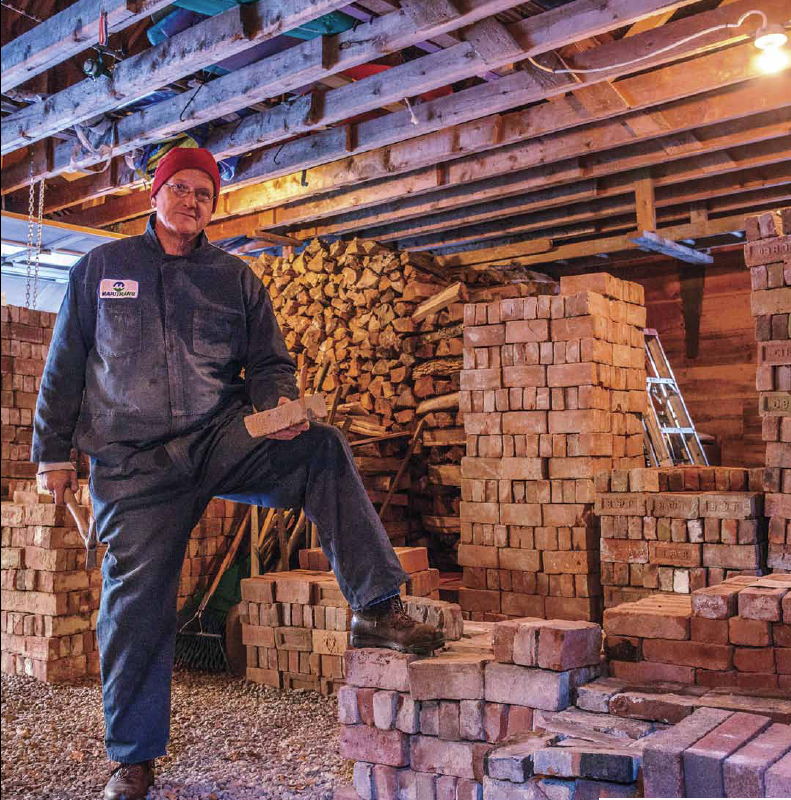 Ancient history is maddeningly stingy with proof as to exactly how things evolved. But, what clues we have suggest that the straightforward craft of patting muddy clay into wooden molds may have begun in what is now southern Turkey. People figured out that these small, lightweight, sun-dried blocks were a lot easier use for building than laboring to quarry and then haul massive stone slabs down from the distant mountainsides. Kiln-fired brick, a later innovation, is so durable in comparison to marble, which is relatively soft, that it withstands the elements significantly better.
Ancient history is maddeningly stingy with proof as to exactly how things evolved. But, what clues we have suggest that the straightforward craft of patting muddy clay into wooden molds may have begun in what is now southern Turkey. People figured out that these small, lightweight, sun-dried blocks were a lot easier use for building than laboring to quarry and then haul massive stone slabs down from the distant mountainsides. Kiln-fired brick, a later innovation, is so durable in comparison to marble, which is relatively soft, that it withstands the elements significantly better.
Common Material
Even now, nine millennia later, the humble brick is the second most common building material on the planet (after wood).
So, why the sudden curiosity about old bricks? It’s because when I wanted some for a woodstove hearth in my circa 1840 carriage barn house, I met Patrick Branley of Wardsboro, Vermont. He’s an oil barge captain by day, easing fully loaded 300-footers into New York City’s harbor, and for the last thirty years, he’s also run a one-man brick salvage operation. He carries the salty air of long weeks at sea about him, yet sitting down to chat about what I need for my project, he’s mild-mannered, polite, thoughtful, and more than anything, he’s all fired up about saving vintage bricks. It’s a curious marriage of spirits in him—the professional mariner and the sensitive restorationist.
The brickwork in baronial Tudor-era homes of England—badly imitated throughout McMansion subdivisions across America during the 20th century— was a creative celebration of bricks laid in intricate patterns, bricks jumbled into a lively roofline of dormers, towers, turrets and gables, and bricks rising into tall, elaborate chimney pots with terracotta tile ornaments.
“Brick has been good to me,” says Branley, quite plainly. “I started the Wardsboro Brick Salvage Company because I always wanted a business of my own, and at first I was driving around to urban renewal sites collecting old bricks that I could resell. I hauled them home in the trunk of my wife’s Subaru.” What Branley realized was that even on a small scale there was a way to make extra money by recycling bricks from the collapsing textile mills around New England and from once-elegant, but now decaying brick mansions being torn down in inner city neighborhoods. The bricks he reclaims are not ancient, but many of them are indeed antique. He also saves miscellaneous architectural elements, such as carved stone lintels from doors and windows, decorative marble mantels, elegant steps, stone blocks and cobbles—period details wrought by fine craftsmen that would have otherwise gone into landfills, never to be seen again. Branley tells me, with heartfelt nostalgia, “Some of the things I salvage were handmade a hundred or two hundred years ago and I believe there is still value in them apart from the money I get for them. These things represent a small part of human civilization.”
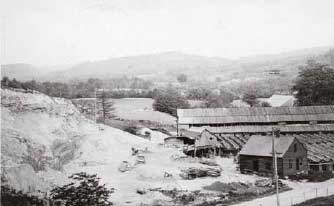
long gone, but there’s still a street in Putney called Brickyard Lane.
Regional Sources
His salvage runs have taken him to demolition sites throughout Vermont and into Massachusetts, Connecticut, New York, Rhode Island, and to wherever contractors send him. “Sometimes I can pull out 500 or more reusable bricks in a few hours and other times, I spend several days at tear-downs before I find the good stuff.” One pickup truckload at a time, every brick he resells will be first cleaned, sorted and labeled. He cradles each brick one by one in a gloved hand and with a type of rock hammer in the other, he flints off bits of leftover mortar with an artisan’s touch and without leaving a scratch on the old brick. This upper-body ballet is not easy work and he has the rock-hard biceps to prove that cleaning reclaimed bricks requires strength and endurance as well as finesse. “The mortar that was mixed with a greater amount of sand is always easier to clean off a brick,” he says, “and the mortar with a lot of cement in the mix, not so much.”
Over the years, Branley has sold thousands of bricks that were manufactured in Vermont’s early brickyards, which is how he learned many of the local makers’ marks. One historical directory lists eight brickmakers operating in Bennington at intervals between 1845 and 1957; there were five at different times in Manchester before 1900; and the Vermont Brick Company ran a yard in Putney from 1911 to 1922. Over in Westminster, Joseph F. Ward’s brickyard employed 10 men who could turn out 1.5 million bricks a year by 1884. Many Vermont farmsteads had brick kilns, a sideline business for extra income. There were hundreds more enterprises around the state, large and small, that came and went. However, most of the oldest bricks that are waiting for delivery in Branley’s storage area bear no dates or identifying stamps as to their manufacturer or place of origin. Yet, he explains to me exactly how each type of brick was made and fired, and he credibly dates the bricks either by judging the measurements, weight, surface texture and color of the clay, or by whether or not it has an indentation, called a “frog.”
By the 15th century in England, floors that had been only packed earth covered in rushes, were paved in brick in wealthier homes. Unglazed brick flooring was used well into the 1800’s in country homes.
“The old bricks are real bricks and they are impossible to replicate,” he says. Bricks used to be made with clay, sand and water, with additives such as lime, iron oxide and magnesia blended in varying proportions, which is why they show such a wide variety of patinas and hardness. “These have great aesthetic value,” he says, “and are further seasoned by time and use. They are so much more appealing than modern bricks. Those are typically made by adding dye to shale slurry to give it some brick-like color.” I get the impression that Branley believes the crisp, bright red rectangular blocks that the big box home improvement stores sell should not even be called “bricks” in the same sense that something labeled “imitation crabmeat” is also a blasphemy.
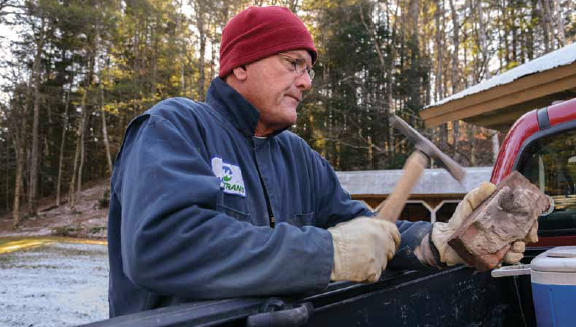 Choosing Old Bricks
Choosing Old Bricks
One important tip he passes on to me before I select some vintage bricks to install around my old J.tul stove is this: for exterior construction choose bricks that are either red or dark red, and choose those that have harder, sharper edges. For decorative landscaping and interior projects, he says, “Go for character, rather than uniformity.” In a special corner among his meticulously stacked palettes of bricks, he sets aside certain bricks. These have the unmistakable thumbprints of the brickmakers; others have the tracks of birds or squirrels that scurried across the moist clay; and some have the fossil-like impressions of leaves that fell on top of the wooden molds. Each one has captured a pinprick of the passing of time, long ago moments that Branley feels are worth cherishing forever. All the odd bricks enchant me, but he cautions me, “If you want to use a variety of nonconforming bricks and clinkers, make sure you hire a mason who has an interest in creativity.”
Preservation specialists adhere to many guidelines for restoring old brickwork. They advise that repairs to badly deteriorated and missing parts should be made with limited replacements of the same type of bricks or with compatible substitute material. The key words there are “limited” and “compatible.” Don’t use more than absolutely necessary of the replacements, and make sure they blend in with the original bricks. What do they advise you not to do? Do not use any a substitute material for repairs that “does not convey the visual appearance of the surviving parts of the masonry feature or that is physically or chemically incompatible.” That’s the same way of telling you that it is going to take you a little bit of time to source old bricks that have the correct history, as well as the right molecules. A handy bullet-list of do’s and don’ts titled “Guidelines for Rehabilitating Historic Buildings: Masonry” is available online at www.gsa.gov/portal/content/112190. The Brick Industry Association also has dozens of technical guides for brick construction at www.gobrick.com/Technical-Notes.
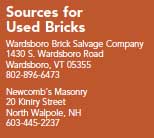 “There is more creativity involved working with old bricks,” says Don Newcomb Jr. of Newcomb’s Masonry. “In each course, you have to blend the colors of salvage bricks carefully because they’re usually not all the same matching color.” Newcomb’s business is in North Walpole, just across the Connecticut River from Bellows Falls and it has been a family-run business since the 1970s. His father began teaching him the trade when he was just 10 years old, while his mother was doing the bookkeeping at home with sharpened pencils, ledger books and an adding machine. His parents are retired now and the business has grown far beyond the family’s kitchen table. He’s running crews of up to eight stonemasons and bricklayers, depending on the scope and number of jobs under contract.
“There is more creativity involved working with old bricks,” says Don Newcomb Jr. of Newcomb’s Masonry. “In each course, you have to blend the colors of salvage bricks carefully because they’re usually not all the same matching color.” Newcomb’s business is in North Walpole, just across the Connecticut River from Bellows Falls and it has been a family-run business since the 1970s. His father began teaching him the trade when he was just 10 years old, while his mother was doing the bookkeeping at home with sharpened pencils, ledger books and an adding machine. His parents are retired now and the business has grown far beyond the family’s kitchen table. He’s running crews of up to eight stonemasons and bricklayers, depending on the scope and number of jobs under contract.
He says, “We used to do a lot more with salvage brick in the 1970s and ‘80s. These days the trend seems to be more towards using rustic and polished stone inside homes as well as outside. Sometimes I still get clients who want that authentic early American look.” One of the most detailed projects he has done with reclaimed bricks was large 18th century-style fireplaces and other exposed brickwork at a bed and breakfast near Chester. The innkeeper wanted to recreate what Newcomb calls “a Colonial Williamsburg” decor.
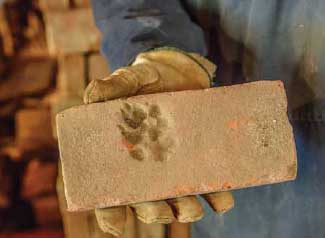
coyote…or maybe even a wolf.
You can tell by Newcomb’s quiet personality he’s going to be a patient perfectionist when he is working with old handmade bricks. He says, “When rI have a project that calls for salvage brick there’s always a lot more math involved. The sizes vary quite a lot even though they originally came from the same demolition site and I have to do a lot of planning before I even start to get the width of the mortar joints and placement of each brick just right.” He mentions that these days it’s possible to hire competent stonemasons, while truly a talented, old-school bricklayer is harder to find. Even when a client wants to use historic bricks in a construction project, Newcomb and his team still have to do the job to meet the standards of current building codes. Another challenge in itself.
The broad walk-in hearths of the homes in 17th and 18th century New England often had brickwork that curved towards the back, rather than forming squared off “cheeks” on the left and right inside walls.
After an hour browsing through a dozen different kinds of bricks with Branley, he helps me figure out how many I need, and I take home seventy of the smaller, handmade bricks, the ones with no frogs. My plan to install the brick hearth involved a lot of preliminary measuring, just as Newcomb said it would. First, I built a shallow wooden frame out of molding to surround the woodstove and chimney and I nailed that to the old plank floor. I painted the frame a dark, burnt red color. Then, I lined the floor area inside the frame with sheet metal and over that, I evenly spread a half-inch deep layer of clean sand. It took me only about an hour to set the bricks in place in the sand, taking my time to rearrange the different colors of the bricks in a pleasing pattern. In the end, I was amazed that these bricks looked just as good the second time they are being used as they did the first time nearly two centuries ago. Maybe even better. ◊
Anita Rafael lives and works in Wardsboro. Her home, a carriage barn conversion, was featured in Stratton Magazine in 2008.

